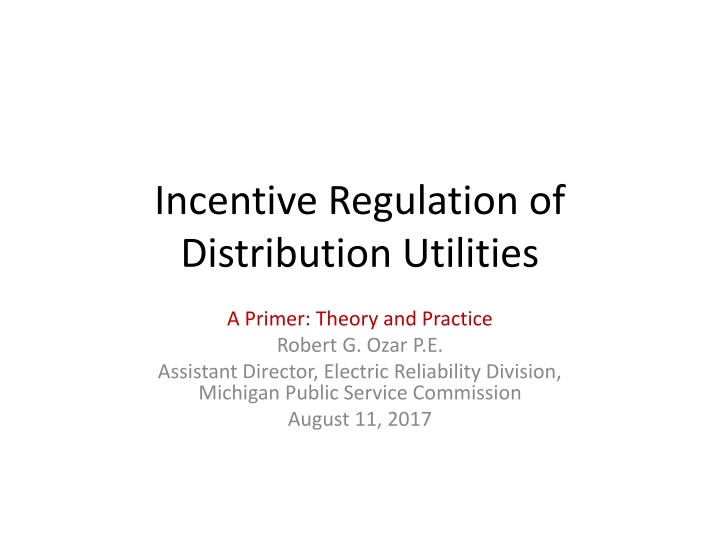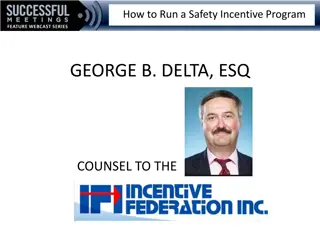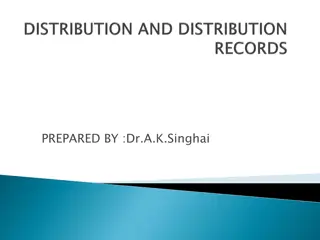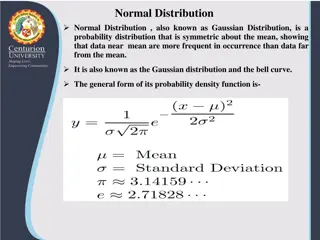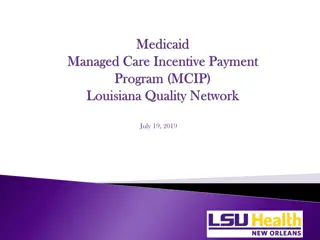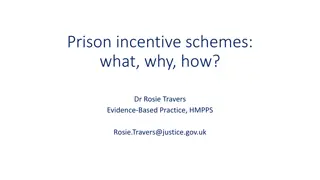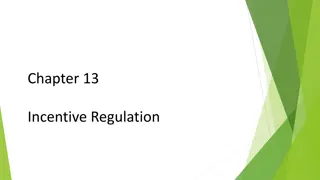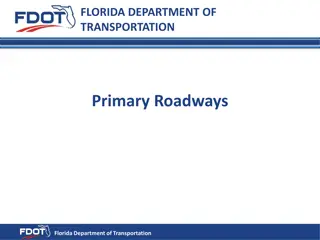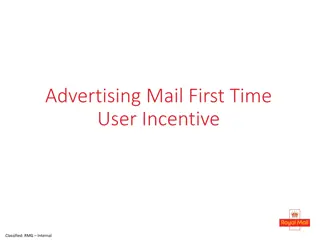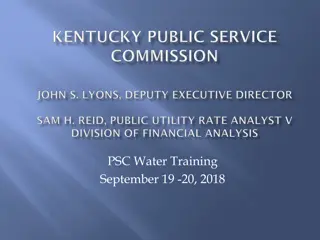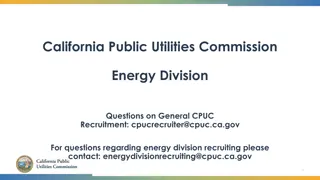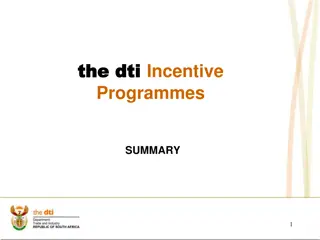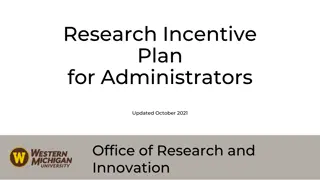Incentive Regulation of Distribution Utilities
This primer by Robert G. Ozar provides a comprehensive overview of the theory and practice of incentive regulation for distribution utilities, offering valuable insights into this important aspect of utility management.
Download Presentation

Please find below an Image/Link to download the presentation.
The content on the website is provided AS IS for your information and personal use only. It may not be sold, licensed, or shared on other websites without obtaining consent from the author.If you encounter any issues during the download, it is possible that the publisher has removed the file from their server.
You are allowed to download the files provided on this website for personal or commercial use, subject to the condition that they are used lawfully. All files are the property of their respective owners.
The content on the website is provided AS IS for your information and personal use only. It may not be sold, licensed, or shared on other websites without obtaining consent from the author.
E N D
Presentation Transcript
Incentive Regulation of Distribution Utilities A Primer: Theory and Practice Robert G. Ozar P.E. Assistant Director, Electric Reliability Division, Michigan Public Service Commission August 11, 2017
Section 1: Economic and regulatory foundations
Basis for Public Utility Regulation Natural monopoly high capital costs, high barriers to entry, cannot move or transfer facilities to gain new markets Economic regulation substitutes for market competition Prevents abuse of monopoly power protects consumers
Double Task of Economic Regulation Determine the sum of revenues that a regulated utility is allowed to collect [remuneration challenge] Operating costs Investment costs (return of and on investment) Determine how the revenues will be collected [tariff challenge] Cost allocation Rate design
Remuneration Challenges A regulated utility s realized costs depend on: its underlying cost opportunities [i.e. whether is it a high-cost or low-cost utility] the decisions made by its managers to exploit cost saving opportunities Utility managers know more about their cost opportunities than the regulators Regulators cannot directly observe managerial effort Incomplete information introduces information asymmetries
Opportunity for strategic behavior Utility may attempt to use its information advantage in the regulatory process to increase its allowed revenues and profits (or other objectives) convince the regulator that it is a higher cost firm than it really is take advantage of the regulator s need to ensure the financial viability of the utility [firm participation constraint]
Firm Participation Constraint By participating in the regulatory process, the regulated firm remains financially sound [viable] Reverse game theory the goal (outcome) is given: the financial viability of the firm is never harmed. regulatory mechanisms are selected by the regulator to achieve such goal [e.g. an incentive mechanism]
Regulators face an adverse selection problem X Efficient Cost Allowed Cost Firm Information Asymmetry Participation Constraint Cost Screening Utility Requested Cost Adverse selection occurs when there's a lack of symmetric information prior to a deal between a buyer and a seller [Investopedia]
Economic Efficiency: Definitions Productive efficiency: the degree to which a firm minimizes the inputs used to produce a given level of output X efficiency: the degree of productive efficiency under conditions of imperfect competition. Cost x-efficiency theory asserts that under conditions of less-than-perfect competition, inefficiency may persist. [Investopedia] Allocative efficiency: occurs when price equals the marginal cost of production (perfectly competitive market). Monopolies can increase the price above the marginal cost of production (allocative inefficiency) Economic rent: generally, unearned income Price
Remuneration Challenges Continued Cost-of-service vs Incentive Regulation Regulators attempt to balance the tradeoff between: Incenting managerial effort to pursue cost savings [x- efficiency] X-efficiency Allocative Efficiency Minimizing abuse of market power (economic rents) collected from ratepayers [allocative efficiency]
Regulatory Process Definitions Ex post - Latin after the fact review based on historical costs, revenues, earnings Ex ante Latin before the event - review based on projections of costs, revenues,earnings or actions planned for the future period Historical Future Ex post Ex ante
Section 2: Cost-of-Service regulation and Incentive regulation [contrasted and compared]
Cost-of-Service Regulation Defined Allowed revenues set equal to realized costs plus a return on investment In theory A regulatory mechanism where the firm is assured that it will be compensated for all of the costs of production that it actually incurs. No excess profits left on the table since revenues are equal to actual (pro-forma) costs No ex postrenegotiation [retroactive ratemaking prohibited] In practice The firm is given an opportunity to earn its authorized rate of return but not a guarantee The used and useful standard allows the removal from rate- base of net plant that is no longer providing service, [or the level of service intended]
Cost-of-Service Regulation Pros and Cons Pros Cons Significant x-inefficiency Blunted management incentive to pursue cost savings [especially long-term savings] Managerial moral hazard issue (cost borne by ratepayers) Minimizes the impact of uncertainty Allowed revenues meaningfully tied to the firm s realized [pro- forma] costs Frequent ex post reviews Limited return Ex post recovery of CAPEX Readily ensures that utility remains financeable [meet the firm participation constraint] Maximizes allocative efficiency Moral hazard occurs when one person takes more risks because someone else bears the cost of those risks [Wikipedia]
Incentive Regulation Defined Regulatory mechanisms designed to provide powerful economic incentives for regulated firms to: reduce costs make efficient infrastructure investments improve service quality (in a cost effective way) provide efficient pricing of regulated services. introduce new services Diverse range of mechanisms Weakens the link between utility costs and rates Two key attributes: automatic adjustment mechanisms uses external data to set allowed revenues
Incentive Regulation Pros and Cons Regulator caps allowed revenues or prices ex ante for a set period Pros Powerful incentive to optimize x-efficiencies Empowers managerial efforts to reduce costs below price or revenue cap Earnings depend on beating the cap Cons Reduces allocative efficiency Potential for significant economic rents Significant exposure to uncertainty/risk Allowed revenues based on exogenous (non-utility) metrics Incurs the full cost of adverse selection Regulator must set high prices to ensure firm participation constraint met
Actual Implementation - Less Distinction Between Approaches Cost of Service Use of fully projected (ex ante) test-year Disconnects allowed revenues from realized [pro-forma] costs Softens benefits of regulatory lag [associated with use of an historical test-year and with case processing delays] Project pre-approval weakens X-efficiency incentives Increases adverse selection issue Used and useful standard rarely exercised Incentive Regulation Periodic ratchets of revenue or price cap Realign revenues with actual (x-efficient) cost trends Transfers economic savings from utility to ratepayers [increases allocative efficiency] Revenue sharing creates nexus between allowed revenues and actual costs
Evolution Will Impose New Demands and Increased Competition on Utilities Evolutionary drivers: Will require utilities to focus on delivering improved outputs at a competitive cost [high performance] May create substantial future investment opportunities to provide enhanced grid services to connect new DG users, manage bidirectional flows/supply volatility, However COS regulation focuses on the prudence of inputs Challenging to respond to evolving demands for outcomes or improved performance COS regulation requires utilities to meet no more than minimum performance levels Provides little incentive (reward) for delivering a higher quality of service or new services
Additional Challenges Related to Pure Cost-Plus Regulation Key utility-management hurdle is getting CAPEX included in rate-base Backward looking nature of COS regulation can impede utility efforts to innovate Apparent high risk related to investment in emerging technologies [ex post regulatory review] In actuality, difficult for regulators to identify (and disallow) all but the most obvious imprudent or wasteful investments CAPEX Rate-Base
Trade-offs Between CAPEX and OPEX Under Cost-of Service Regulation After CAPEX included in rate- base, marginal reward to take full advantage of cost savings opportunities (x-efficiency) I. Utilities only profit from realized savings until the next rate case [when historical cost savings are folded into pro-forma cost calculation] II. Utilities focus on short-term cost savings [OPEX], sacrificing long- term opportunities III. Marginal penalties for failure to take full advantage of capabilities of approved CAPEX. Regulators are reluctant to remove or reduce plant in service for infraction of used and useful standard.
COS and a Regulated Utilitys Strategic Business Model When faced with the choice between a capital investment [CAPEX] or an expense [OPEX] a regulated IOU will tend to choose the CAPEX route despite x- efficiency benefits of the latter. Examples: Build out of a private data (mesh) network for smart meters vs. contracting with a public telecommunications carrier for point-to-point cellular service Depreciation unit defines replacement size; may affect repair/replacement decisions
Preferable Regulatory Mechanism Balance between a pure cost-of-service and pure incentive regulation COS Incentive
Role of Economic Incentives for Investor Owned Utilities Economic incentives are the key to signaling that a certain investment or decision is valued or encouraged and another is relatively discouraged Holds true irrespective of which regulatory model is used by regulators
Incentive Regulation Strategic Goal Incentive-based regulatory mechanisms make it profitable for regulated utilities to make x-efficiency improvements and yield consumer benefits (in the long run) Regulated firms may earn significantly higher returns than their cost of capital when these excess returns are achieved from cost savings beyond the benchmark In theory, if the firm over performs against the target, consumers eventually benefit at the next price review ratchet
Section 3: Price Cap regulation is the historical foundation of Performance Based Regulation
The Road to RIIO Vertically Integrated Natural Monopoly Generation Transmission Distribution Retail Sales Transmission Separation of Competitive Segments Network Operator Introduction of Incentive Regulation Cost Control Y Reliability N Service Quality N Strategic Behavior Y Allocative Efficiency N Price Cap Revenue Cap + Performance Incentive Mechanisms + Profit Sharing & Menu of Contracts + TOTEX Benchmarking RIIO
Pure Price-Cap Incurs the Full Costs of Adverse Selection A pure price cap mechanism does not respond to: Changes in managerial efforts (cost savings) Ex post cost realization (no reconciliation) Pros Highest powered incentives to exploit cost opportunities Utility can claim in full any variance between the target and actual operating costs Cons Regulator will have to set prices high enough to cover the firms realized costs Regulator must adhere to firm participation constraint despite uncertainty about cost opportunities [must assume that the firm may be inherently high cost] Leaves economic rents to the firm Focus on costs may lead to poor quality of service
Price-Cap Index (CPI) Competitive Market Standard The long-run trend in an industry s (output) prices is equal to the long-run trend in its unit costs ? ?????? ?????? = ? ???? ???? ( ) is equal to the long-run growth trend (%/yr.) ?? ??) ? ???? ln( ?? ???? i.e. ???? ????? = ? ? ??? ? = ?? ?? ln( ) 1/? ???? ???? ???????? ?? ?????? ?? ? ???? ???? = 1 ? ???? ???? ?????????????? ?? ??????
Competitive Market Standard In Terms of Macro-economic Measures The trend in the unit cost is equal to the difference between trends in that industry s input price index and total factor productivity (TFP) index. Same for economy as a whole. ? ???? ????????????= ? ????? ?????????????? ? ??????????? Eq. a Eq. b ? ???? ???????????= ? ????? ????????????? ? ?????????? Subtract Equation (b) from Equation (a)
General Price-Cap Index (PCI)Formula Derivation of Productivity Offset ? ???? ???????????? ? ???? ???????????= ? ????? ????????????? [? ??????????? ? ??????????] Rearranging: ? ????? ?????????????? ? ???? ????????????= ? ???? ???????????+ ? ????? ????????????? [? ??????????? ? ??????????] ? ????? ?????????????? Recognizing the Competitive Market Standard ? ??? = ? ?????? ?????? = ? ???? ???????????? = ? ???????? ? ????? ????????????? ? ????? ?????????????? ? ??????????? ? ?????????? ? ??? = ? ???????? ? ? ??? ? = ????????????? ????????? ???????
What is the Productivity Offset X reflects {in theory} the sum of: the difference between the target Total Factor Productivity (TFP) growth rate for the utility and the TFP growth rate for the economy as a whole, and; the difference between input prices faced by firms in the general economy and (expected) input prices of the regulated firm X= ? ????? ????????????? ??????? ? ????? ?????? ??????? ?????????? ??????????? ??????? + Regulated prices should rise at a rate that reflects the general rate of inflation [????? ???????????] less an offset [X] for: (1) higher (or lower) productivity growth, and: (2) for higher (or lower) input price inflation
Basic Formula for a Pure Price-Cap Regulation For the first year, a full cost-of-service calculation of projected revenue requirements [allowed revenue], a COSS, and rate design is performed Thus, ?0= ? ??0 For the following years: ?1= ?0 1 + ????????? ?1 ?2= ?1 1 + ????????? ?2 ?3= ?2 1 + ????????? ?3 ????? ???= ?(??) Automatic Adj. Mechanism
RPI-X Price-Control Method Regulatory Building Blocks Many similarities to practical COS regulation [with a fully projected test-year] Characterized as a combination of: Cost-of-service regulation [capital and operating cost recovery] Capital investment plan reviewed and approved ex ante (projected) reasonableness reviewed ex post Determine an allowed rate-of-return and compatible valuations of the rate-base and depreciation rates Set projected operating costs via indexes or comparative benchmarking Price ratchets setting new starting values for prices (cost-contingent) Performance standards for quality of service (with financial incentives for meeting or exceeding performance standards, or penalties for failure)
RPI-X Price Cap Mechanism P0 = initial price, set by allowed revenues over multi-year period P1 = year 2 adjusted price n = number of periods (5) RPI = [Retail Prices Inflation] = {change in general inflation} 1/? ????????? ???????? ?? ?????? ????????? ?????????????? ?? ?????? ??? = 1 X = productivity offset P1 = P0 * [1 + (RPI X)]
How the Price Cap is Set P0 is chosen so that the present value of revenues are equal to the present value of the total operating and capital costs (depreciation plus return) that have been allowed during the five year review period: [?????????? = ???????] 4 ??[1 + (??? ?)]?(?? )?(1 + ?) ? ?? ??????? = ?=0 4 [ $????? ??????? ?????????????1 + ? ?] ??????? = ?=0 Where d is the discount rate; (kWh) is the forecasted demand Solving for P0: 4 [ $????? ??????? ?????????????1 + ? ?] ?=0 1 + ??? ? ]?(?? )?(1 + ?) ? ?=0 ??= 4 Note that P0 would be a vector of prices for multiple services or rate schedules; and that this simplified calculation assumes a uniform annual commodity) charge.
RPI-X Insights Contrary to popular misconception, the price-cap formula [P = f(RPI, X)] does not actually determine the level of approved revenues (over the 5-year control period) Note: a pure price-cap mechanism does The PPI X mechanisms is actually an ex ante revenue- control mechanism. The mechanism requires a full projected cost-of service (COS) calculation of revenue requirements, a depreciation study, a COSS and rate design. The regulated firms ability to determine the structure of prices under an overall revenue cap is limited
UK(United Kingdom) Price-Cap Implementation Issues Large increases in investment approved for the next multi-year price control period would result in a price spike between the end of the prior price control period and the beginning of the next. [price shock] UK Regulators smoothed the price increase by building in a steeper escalation of the retail price [resulted in a lower initial price P0 and back-loading of the revenues toward the end of the period] Productivity offset X set to zero, thus retail price escalation during price control period only reflected general inflation: P1=P0*(1 + RPI); P2= P0*(1+RPI)2 etc. Improvements in operating cost efficiency (X) rolled into the cost-plus- return calculation [benchmarking] of targeted revenue requirements Typically initial price P0 set in a range from [- 10% to + 10%] from the last price control period, with a mean of ~+1% Lesson learned: Practical implementation may require deviation from theory - nothing is set in stone!
Original Impact of RPI X Price Curve Levelized 5 year Cost vs. Price Curve 25 Price Spike 20 15 10 5 Price Curve Levelized Cost 0 1 2 3 4 5 6 7 8 9 10 11 12 13 14 15 16 17 18 19 20 21 22 23 24 25 Price A
Levelized Cost V.S. RPI-0 Price Curve Levelized 5 year Cost vs. Price Curve 25 20 15 10 5 Price Curve Levelized Cost 0 1 2 3 4 5 6 7 8 9 10 11 12 13 14 15 16 17 18 19 20 21 22 23 24 25 Price A
Comparative Benchmarking of Operating Expenses (OPEX) Assessment of efficiency of distribution company operating costs OPEX subjected to comparative regression- based benchmarking Benchmarking allows regulators to project the efficient level of operating expenses [RPI X] e.g. x-efficiency implicitly reflected in forecasted OPEX
Practical Capital-Cost Recovery Issues Significant efforts required to develop the target capital expenditure schedule during the next [five-year] price control period Utility presents its proposed investment budget, and regulators evaluate using its staff (or outside engineering consultants) and third parties evidence [expert appraisal] Traditionally highly contested Increasing importance of future distribution investments due to: (1) aging of the grid; (2) related reliability and service quality issues; and (3) infrastructure enhancement projects
Performance Based Regulation Foundations for Further Evolution Under pure COS regulation ??????????= ?(?????????/??????????) > ???????????) full impact of managerial moral hazard Poor Good Allocative Efficiency Managerial Efficiency Under pure Price Cap regulation ??????????= ?(? > ????????? ~ ?? ?????????) Poor Allocative Efficiency Good Managerial Efficiency full impact of adverse selection ? =[regulator s assessment of efficient costs of the highest cost type]
Performance-Based Regulation Essential Foundations Greater economic efficiency derived from a regulatory mechanism in which allowed revenues are: (1) partially fixed ex ante, and (2) partially responsive to changes in realized costs ????????= ? ??????? ????+ ????????????? Profit sharing Mechanism ????????= ??? ???? ??? ???? ????????? ? ? = sharing factor
Example: Price Cap + Profit Sharing Trade off X-Efficiency for Allocative Efficiency ????????= ??? ???? ??? ???? ????????? ? ? Let ? = [regulators assessment of efficient costs of the highest cost type]; =profit sharing level,[0< <1] ????????= ? { ? ????????? ? ? } Thus: ????????< ? where ????????? ?? ????????? Revenues Increased Allocative Efficiency Reduced Impact of Adverse Selection Costs
Performance-Based Regulation Essential Foundations Even better economic efficiencies may be obtained with a sliding- scale menu of profit-sharing contracts Prices are partially fixed ex ante, and partially responsive to realized costs The utility picks a contract from the menu by filing their ex ante forecast. The ratio of their request to the regulator s base estimate determines the allowed revenue, and the level of sharing The menu of contracts satisfies the incentive compatibility constraint Utilities with low cost opportunities choose a high profit-sharing contract, and those with high cost opportunities choose a low profit- sharing contract For any realized cost, the utility earns the most income when its filed forecast equals the realized cost
Sliding-Scale Menu of Profit Sharing Contracts Performance Based Regulation Allowance for future CAPEX required to meet reliability targets subject to increased scrutiny and contention Large amount of infrastructure has reached (or nearing) end of its useful life (retirement, replacement, and early retirement issues) Increased importance of reliability Emergence of new technologies Utility given choice of incentives depending on their ability to control costs Most Control Least Control
Sliding Scale Mechanism For CAPEX Sliding scale menu at discretion of utility management Menu forces the utility to reveal its type ex post [type means high-cost or low- cost] Resolves the asymmetric information problem facing regulators Choice between 100% and 100+ y% of base capital expenditure allowance Regulated firm can choose from a menu of contracts: A lower capital expenditure allowance High sharing factor Higher expected return A higher capital expenditure allowance Low sharing factor Lower expected return The sliding scale mechanism applies to capital cost variations but not operating cost variations
U. K Sliding Scale Incentive Mechanism Calculation of Allowed Ex Ante CAPEX 120 Overweighting of Regulator s Ex Ante Estimate ????????= 0.25 ?????+ 0.80 (?????)????????? 115 115 113.75 ???????? ????? 100 112.5 111.25 110 110 108.75 107.5 106.25 105 105 100 100 105 110 115 120 125 130 135 140 ????? ????? 100
U. K Sliding Scale Incentive Mechanism for CAPEX Profit Sharing Factor as a % of CAPEX Savings: ??????? = ?? [???????? ?????????] ????? ????? ?? = 0.50 + 0.90 45 40 40 38 35 35 33 30 30 28 Efficiency Incentive % 25 25 23 20 20 15 10 5 0 100 105 110 115 120 125 130 135 140 ????? ????? ???????????= 0.40 100
